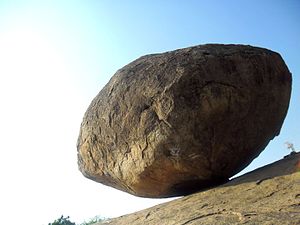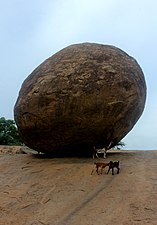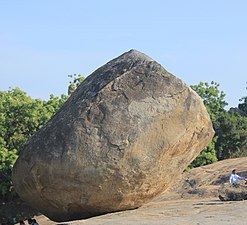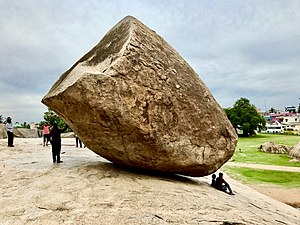Krishna's Butterball: Difference between revisions
CleanupBot (talk | contribs) m (clean up) |
No edit summary |
||
| Line 5: | Line 5: | ||
[[File:Tricky_rock.jpg|alt=|thumb|Krishna's Butterball, side profile viewed from west to east.]] | [[File:Tricky_rock.jpg|alt=|thumb|Krishna's Butterball, side profile viewed from west to east.]] | ||
'''Krishna's Butterball''' (also known as '''Vaan Irai Kal'''<ref name=":0">{{Cite web|url=http://www.atlasobscura.com/places/krishnas-butter-ball|title=Krishna's Butter Ball|website=Atlas Obscura|access-date=2016-09-27}}</ref> and '''Krishna's Gigantic Butterball''') is a gigantic [[granite]] [[boulder]] resting on a short incline in the historical coastal resort town of [[Mamallapuram]] in [[Tamil Nadu]] state of India.<ref>{{cite news|author1=Eric Grundhauser|title=The Delicately Balanced Beauty of Krishna's Butter Ball|url=http://www.slate.com/blogs/atlas_obscura/2015/08/04/the_delicately_balanced_boulder_known_as_krishna_s_butter_ball_is_a_lovely.html|accessdate=21 May 2016|work=Slate|date=4 August 2015}}</ref> | '''Krishna's Butterball''' (also known as '''Vaan Irai Kal'''<ref name=":0">{{Cite web|url=http://www.atlasobscura.com/places/krishnas-butter-ball|title=Krishna's Butter Ball|website=Atlas Obscura|access-date=2016-09-27}}</ref> and '''Krishna's Gigantic Butterball''') is a gigantic [[granite]] [[boulder]] resting on a short incline in the historical coastal resort town of [[Mamallapuram]] in [[Tamil Nadu]] state of India.<ref>{{cite news|author1=Eric Grundhauser|title=The Delicately Balanced Beauty of Krishna's Butter Ball|url=http://www.slate.com/blogs/atlas_obscura/2015/08/04/the_delicately_balanced_boulder_known_as_krishna_s_butter_ball_is_a_lovely.html|accessdate=21 May 2016|work=Slate|date=4 August 2015}}</ref> | ||
Being part of the [[Group of Monuments at Mamallapuram]], a UNESCO [[World Heritage Site]] built during | Being part of the [[Group of Monuments at Mamallapuram]], a UNESCO [[World Heritage Site]] built during the seventh- and eighth-century CE as Hindu religious monuments by the [[Pallava dynasty]], it is a popular tourist attraction.<ref name="Lochtefeld2002p399">{{cite book|author=James G. Lochtefeld|title=The Illustrated Encyclopedia of Hinduism: A-M|url=https://books.google.com/books?id=5kl0DYIjUPgC&pg=PA399|year=2002|publisher=The Rosen Publishing Group|isbn=978-0-8239-3179-8|page=399}}</ref><ref name=Unesco>{{Cite web|url=https://whc.unesco.org/en/list/249/|title=Group of Monuments at Mahabalipuram|accessdate=23 October 2012|publisher=UNESCO.org}}</ref><ref>{{cite news|author1=Neha Vashishth|title=These Mysterious Places In India Totally Defy Gravity!|url=http://daily.bhaskar.com/news-hf/LIF-WEW-weird-places-in-india-where-gravity-has-no-power-5300560-PHO.html|accessdate=22 May 2016|work=dailybhaskar|date=16 April 2016}}</ref> It is listed as a protected national monument by the [[Archeological Survey of India]].<ref>{{cite web |title=Alphabetical List of Monuments – Tamil Nadu |url=http://asi.nic.in/alphabetical-list-of-monuments-tamil-nadu/ |url-status=dead |archive-url=https://web.archive.org/web/20180919070208/http://asi.nic.in/alphabetical-list-of-monuments-tamil-nadu/ |archive-date=19 September 2018 |access-date=12 January 2022 |website=asi.nic.in}}</ref> | ||
==Etymology== | ==Etymology== | ||
| Line 13: | Line 13: | ||
==History== | ==History== | ||
[[File:Butter_well_at_Mahabalipuram.jpg|alt=|thumb|right|Butter well, 40 | [[File:Butter_well_at_Mahabalipuram.jpg|alt=|thumb|right|Butter well, {{convert|40|m|ft}} north of Krishna's Butterball]] | ||
The [[Pallava]] king [[Narasimhavarman]] (630–668 CE) also made a failed attempt to move the boulder.<ref name=":0" /> The Indian [[Tamil people|Tamil]] king [[Raja Raja Chola]] (985 and 1014 CE) was inspired by the balance of this massive stone boulder and it led to the creation of never-falling mud dolls called ''[[Thanjavur doll|Tanjavur Bommai]]'', which having a half-spherical base tends to come back to its original position every time one tries to make it fall.{{ | The [[Pallava]] king [[Narasimhavarman]] (630–668 CE) also made a failed attempt to move the boulder.<ref name=":0" /> The Indian [[Tamil people|Tamil]] king [[Raja Raja Chola]] (985 and 1014 CE) was inspired by the balance of this massive stone boulder and it led to the creation of never-falling mud dolls called ''[[Thanjavur doll|Tanjavur Bommai]]'', which having a half-spherical base tends to come back to its original position every time one tries to make it fall.{{citation needed|date=September 2018}} In 1908, then-governor of the city [[Arthur Havelock]] made an attempt to use seven elephants to move the boulder from its position due to safety concerns but with no success.{{citation needed|date=September 2018}} On 12 October 2019, Indian Prime Minister [[Narendra Modi]] and Chinese President [[Xi Jinping]] took a photo in front of Krishna's Butterball holding hands during their second "informal summit".<ref>{{Cite news|url=https://www.thehindu.com/news/national/camaraderie-marks-start-of-modi-xi-informal-summit/article29660482.ece|title=Camaraderie marks start of Modi-Xi 'informal summit'|last=Ramakrishnan|first=T.|date=2019-10-11|work=The Hindu|access-date=2019-10-19|language=en-IN|issn=0971-751X}}</ref> | ||
==Details== | ==Details== | ||
The boulder is approximately 6 | The boulder is approximately {{convert|6|m|ft|spell=in}} high and {{convert|5|m|ft|spell=in}} wide and weighs around {{convert|250|t|ton}}.<ref>{{cite news|author1=Samonway Duttagupta|title=7 of the most incredible natural wonders in India|url=http://indiatoday.intoday.in/story/7-of-the-most-incredible-natural-wonders-in-india-maharashtra-lonar-tamil-nadu-kerala-valley-of-flowers-karanataka-travel/1/635723.html|accessdate=21 May 2016|work=[[India Today]]|date=5 April 2016}}</ref> It seems to float and barely stand on a slope on top of {{convert|4|ft|m|adj=on|order=flip|sp=us}} high plinth which is a naturally eroded hill and is said to have been at the same place for 1,200 years.<ref name=":0"/><ref name=IndiaTimes>{{cite web |url=http://www.indiatimes.com/culture/travel/this-is-krishna-s-mysterious-butter-ball-rock-and-it-has-never-rolled-downhill-250079.html |title=This Is Krishna's Mysterious 'Butter Ball' Rock And It Has Never Rolled Downhill |author=Neha Borkar |date=7 February 2016 |work=IndiaTimes |accessdate=29 September 2016}}</ref> A part of the boulder on top back has eroded away, making it look like a half-spherical rock from the back, while it appears round shaped from other three sides. | ||
==Gallery== | ==Gallery== | ||
<gallery mode=packed heights=" | <gallery mode="packed" heights="150"> | ||
File:Krishna's Butter Ball, Mamallapuram.JPG|Krishna's Butter Ball, side profile viewed from east | File:Krishna's Butter Ball, Mamallapuram.JPG|Krishna's Butter Ball, side profile viewed from east to west | ||
File: | File:India - Temples & Towers - 018 - Mamallapuram - Krishna's Butterball.jpg|viewed from south to north | ||
File:Krishna' | File:Krishna's Butter ball 3.jpg|viewed from southeast to northwest | ||
File:Krishna' | File:Krishna's Butter Ball, Mahabalipuram.JPG|viewed from east to west | ||
File: | File:Krishna Butterballl.jpg|viewed from northeast to southwest | ||
File: | File:Krishna Butter ball.JPG|viewed from north to south | ||
File: | File:Krishna Butter Ball in Mahabalipuram.jpg|viewed from west to east | ||
File:India - Temples & Towers - 019 - Mamallapuram - Krishna's Butterball.jpg| | File:India - Temples & Towers - 019 - Mamallapuram - Krishna's Butterball.jpg|viewed from southwest to northeast | ||
</gallery> | </gallery> | ||
Revision as of 03:04, 15 March 2022
Krishna's Butterball (also known as Vaan Irai Kal[1] and Krishna's Gigantic Butterball) is a gigantic granite boulder resting on a short incline in the historical coastal resort town of Mamallapuram in Tamil Nadu state of India.[2]
Being part of the Group of Monuments at Mamallapuram, a UNESCO World Heritage Site built during the seventh- and eighth-century CE as Hindu religious monuments by the Pallava dynasty, it is a popular tourist attraction.[3][4][5] It is listed as a protected national monument by the Archeological Survey of India.[6]
Etymology
The original name, Vaan Irai Kal, according to the Atlas Obscura, translates from Tamil as "Stone of Sky God".[1] According to Hindu scriptures, lord Krishna often stole butter from his mother's butter handi; this may have led to the namesake of the boulder.[1] In 1969, a tour-guide is said to credit its present name, Krishna's Butterball, to Indira Gandhi who was on a tour of the city.[7]
History
The Pallava king Narasimhavarman (630–668 CE) also made a failed attempt to move the boulder.[1] The Indian Tamil king Raja Raja Chola (985 and 1014 CE) was inspired by the balance of this massive stone boulder and it led to the creation of never-falling mud dolls called Tanjavur Bommai, which having a half-spherical base tends to come back to its original position every time one tries to make it fall.[citation needed] In 1908, then-governor of the city Arthur Havelock made an attempt to use seven elephants to move the boulder from its position due to safety concerns but with no success.[citation needed] On 12 October 2019, Indian Prime Minister Narendra Modi and Chinese President Xi Jinping took a photo in front of Krishna's Butterball holding hands during their second "informal summit".[8]
Details
The boulder is approximately six metres (20 ft) high and five metres (16 ft) wide and weighs around 250 tonnes (250 long tons; 280 short tons).[9] It seems to float and barely stand on a slope on top of 1.2-meter (4 ft) high plinth which is a naturally eroded hill and is said to have been at the same place for 1,200 years.[1][10] A part of the boulder on top back has eroded away, making it look like a half-spherical rock from the back, while it appears round shaped from other three sides.
Gallery
See also
References
- ↑ 1.0 1.1 1.2 1.3 1.4 "Krishna's Butter Ball". Atlas Obscura. Retrieved 27 September 2016.
- ↑ Eric Grundhauser (4 August 2015). "The Delicately Balanced Beauty of Krishna's Butter Ball". Slate. Retrieved 21 May 2016.
- ↑ James G. Lochtefeld (2002). The Illustrated Encyclopedia of Hinduism: A-M. The Rosen Publishing Group. p. 399. ISBN 978-0-8239-3179-8.
- ↑ "Group of Monuments at Mahabalipuram". UNESCO.org. Retrieved 23 October 2012.
- ↑ Neha Vashishth (16 April 2016). "These Mysterious Places In India Totally Defy Gravity!". dailybhaskar. Retrieved 22 May 2016.
- ↑ "Alphabetical List of Monuments – Tamil Nadu". asi.nic.in. Archived from the original on 19 September 2018. Retrieved 12 January 2022.
- ↑ "Krishna's Butter Ball - Ancient Aliens In India? ~ Places on the planet you must see". Retrieved 21 May 2016.
- ↑ Ramakrishnan, T. (11 October 2019). "Camaraderie marks start of Modi-Xi 'informal summit'". The Hindu. ISSN 0971-751X. Retrieved 19 October 2019.
- ↑ Samonway Duttagupta (5 April 2016). "7 of the most incredible natural wonders in India". India Today. Retrieved 21 May 2016.
- ↑ Neha Borkar (7 February 2016). "This Is Krishna's Mysterious 'Butter Ball' Rock And It Has Never Rolled Downhill". IndiaTimes. Retrieved 29 September 2016.










